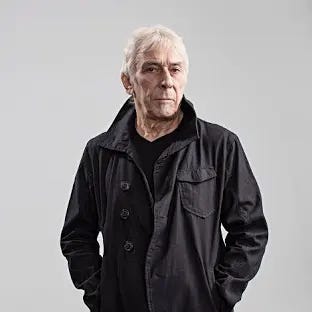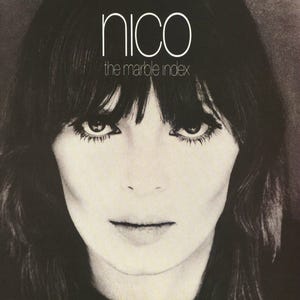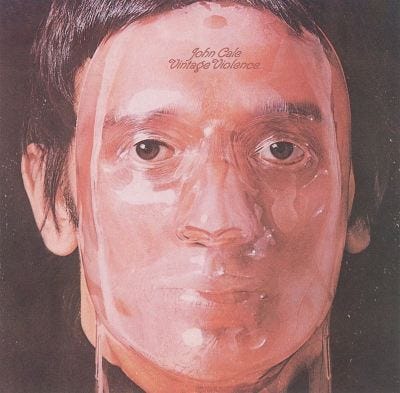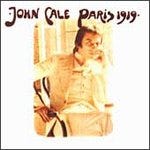The GLW (Greatest Living Welshman), John Davies Cale OBE, aged 83 , arrived on the stage of the Royal Festival Hall playing blistering electric guitar, from a standing position.
Cale left Wales for the New York avant garde in 1963,but there is still a trace of a South Wales accent in his resonant speaking voice. He has something of that dark charisma one finds in actors like Richard Burton, Anthony Hopkins, Jonathan Pryce and, in a different way, Michael Sheen. The first time I heard the song Davies and Wales, I thought the chorus was “Windsor Davies, Windsor Davies,” and was a tribute to another great Welsh actor. (Met Windsor Davies on trains on two occasions.)
Cale was born on 9 March 1942 in the mining village of Garnant in the valley of the River Amman in Carmarthenshire. He came from an extremely poor background. His English father, Will Cale, was a coal miner. His mother, Margaret Davies, was a primary school teacher. Although his father spoke only English, his mother spoke and taught Welsh to John. John began learning English at primary school, at around the age of seven. Cale was sexually abused by an Anglican priest and by a music teacher. He played organ at Ammanford church. Before he reached his teens, the BBC recorded Cale playing a toccata he had composed primarily on the black keys of the piano in the style of Aram Khachaturian.
Having discovered a talent for viola, Cale joined the National Youth Orchestra of Wales at the age of 13. Cale studied music at Goldsmiths College, University of London, after winning a scholarship. While he was there, he organised an early Fluxus (an avant-garde collective) concert, A Little Festival of New Music, on 6 July 1963. He also contributed to the short film Police Car and had two scores published in Fluxus Preview Review (July 1963). He conducted the first performance in the UK of Cage's Concert for Piano and Orchestra, with the composer and pianist Michael Garrett as soloist. Aaron Copland and Leonard Bernstein helped him to get a scholarship to study music in the USA and he moved to New York in 1963. Cale was one of the team of pianists (along with John Cage) who took part in publicly performing Erik Satie's Vexations in full (it took 18-hours).
At the RFH on March 21, after the first number, Shark, Shark, he walked to the keyboards with the kind of shuffling gait that one might expect from someone in his ninth decade. He played the second number, Captain Hook, accompanying himself on piano and remained in a sedentary position at the Kurzweill for the rest of the 100-minute set.
His gait might shuffle but he still has a remarkably powerful voice. Most of the material was from his latest album, POPtical Illusion. Cale wrote 80 songs during the pandemic and has made two albums out of them. The pandemic came between me and Cale in 2022. I had a ticket to see him at the London Palladium but the concert was cancelled and I had to be in Sri Lanka when the rescheduled gig came around on Thursday 9 February 2023.
I am not normally one to take pictures at concerts, but I felt compelled to try to capture a video of Cale in his teacher’s specs against a ceiling-to-floor backdrop of moving images of oriental religious goings-on. I was chastised and humbled by an usherette and I put my gadget away. The recording was not successful.
Cale has been my hero since 1968, when I first heard that first Velvet Underground album with the Andy Warhol banana on the cover. I was immediately captured by Cale’s droning electrical viola on Heroin and the ominous chugging guitars on Waiting for the Man.
I kept an ear on him after that and was particularly taken by his production of The Marble Index for Nico. Incidentally, I am reliably informed that I was once at the same party as Nico.
This was at the unlikely venue of the function room above the Co-op at Platt Fields near Manchester City’s old football ground. Nico was living on a council estate in Broughton at the time. In 1982, she released a single "Procession", produced by Martin Hannett (whom I accompanied to a Focus gig at Manchester Polytechnic) and featuring the Invisible Girls (whose lineup included Steve Hopkins, whose house I lived in.) She was “managed” by the haphazard promoter “Dr” Alan Wise (his grave, in Southern Cemetery, bears the inscription ‘Impresario Extraordinaire’). If only we had met at the Co-op, Nico’s life could have been so different. She would not have had to waste her time with the likes of Alain Delon, Jackson Browne and Jim Morrison.
I bought The Marble Index on vinyl from Boots the Chemists in Gloucester in 1969. I now have it on CD together with another album that Cale produced for Nico, Desertshore. Those albums had much in the way of innovative instrumentation and arrangements. At the RFH, Cale played Frozen Warnings from The Marble Index.
In 1970, while I was living in the Hopkins house in Whalley Range, I bought Cale’s Vintage Violence, which did not seem very avant garde (I remember listening to it while cooking a rather wonderful broad bean and tomato stew in the Wilbraham Road kitchen). Vintage Violence was described by Mark Deming as “a startlingly user-friendly piece of mature, intelligent pop whose great failing may have been being a shade too sophisticated for radio.”
I also bought The Church of Anthrax, a 1971 collaboration between Cale and avant-garde minimalist Terry Riley. Around this time, I was also listening to Riley's A Rainbow in Curved Air and Poppy Nogood and the Phantom Band, minimalist music with an obsessive attention to repetition. Cale had studied with the father of American minimalism La Monte Young and collaborated with him in his Theatre of Eternal Music. (Fun fact: at Los Angeles City College in 1953, Young beat Eric Dolphy in an audition for a coveted spot in the school's jazz band) My vinyl albums became communal property of Wilbraham Road and got very scratched.
In 1972, Cale signed with Reprise Records as a recording artist and staff producer. The Academy in Peril (1972) was his first project for Reprise and is one of my favourites.
The album is mostly instrumental and features the Royal Philharmonic Orchestra on two tracks.
Paris 1919 (1973) has many fine melodies and great singing in that resonant Welsh voice.
The album had a backing band that included Lowell George of Little Feat and Wilton Felder of the Crusaders, and some tracks feature the UCLA Symphony Orchestra. Composed of highly melodic songs with arcane and complex lyrics, it has been judged by critics as one of his best. The album was performed, in its entirety, at the Coal Exchange in Cardiff on 21 November 2009, at the Royal Festival Hall in London on 5 March 2010, and many other venuies in many countries.
Cale moved back to London in 1974, and he made a series of dark and threatening solo studio albums which had a sense of barely suppressed aggression. On Fear (1974), Slow Dazzle (1975), and Helen of Troy (1975) he collaborated with Phil Manzanera and Brian Eno of Roxy Music and ace guitarist Chris Spedding, who played in his live band.
Cale has been influential in many areas of music. Later in the 70s Cale got himself, despite his undoubted musical skills, classical status and versatility, a reputation as the godfather of punk. Not many punk or new wave bands escaped the influence of the Velvet Underground. On April 24, 1977, Cale was playing The Greyhound in Croydon, England (not far from where I am writing this). During Heartbreak Hotel a dead chicken was introduced on stage which Cale decapitated with a meat cleaver and threw the giblets at the audience. Joe Stefko the drummer was a vegetarian and walked off in disgust. Even the aggressive punks slam dancing in front of the stage went quiet. Cale apologised soon after the incident but also said, “It was the most effective show-stopper I ever came up with." Cale did a very scary version of Heartbreak Hotel at the RFH on March 21 but no animals were harmed.
Many of the albums he produced in the 1970s are regarded as important and groundbreaking. His sessions with Jonathan Richman & the Modern Lovers anticipated punk and new wave. Patti Smith's Horses (1975) was one of the most influential recordings of the '70s. He also produced The Stooges, Siouxsie and the Banshees, Sham 69, Menace, The Sick Fucks, Squeeze and the Happy Mondays. He demonstrated his versatility by also producing the classical vocal group The Medieval Baebes and the Breton folkie Alain Stivell.
Leonard Cohen's original version of Hallelujah had not attracted a great deal of attention. Cale had recorded his version of the song for the tribute album I'm Your Fan in 1991. The song only went viral after Cale's arrangement and recording of it and Jeff Buckley's subsequent cover of Cale's arrangement).
I rather lost touch with Cale’s current work until I bought a CD M: FANS, his sixteenth solo studio album, which was released in January 2016. It featured new versions of songs from his 1982 album Music for a New Society.
In a statement, Cale recounted the process of making the album, and how the 2013 death of former bandmate and collaborator Lou Reed had informed it: “Losing Lou [too painful to understand] forced me to upend the entire recording process and begin again...a different perspective - a new sense of urgency to tell a story from a completely opposite point of view - what was once sorrow, was now a form of rage. A fertile ground for exorcism of things gone wrong and the realization they are unchangeable. From sadness came the strength of fire!!!”
Back to March 2, 2025, at the RFH. Cale had backing from a tight three-piece who had long experience of working with him: Dustin Boyer - guitar/samples, Joey Maramba – synth bass/bowed bass, Alex Thomas-drums/synths.
Much of the set came from his latest album, POPtical Illusion.
I sense that there is a lot of repetition in Cale’s current work. I wonder if this goes back to his days with Terry Riley and La Monte Young.
You can check out the set list here and sample the songs:
https://www.setlist.fm/setlist/john-cale/2025/royal-festival-hall-london-england-b52b186.html












I love JC and enjoyed this v much. I saw him last year in Mcr. A great set. The 5th time I’ve seen him. I also used to live off Wibraham Road but in the 90s.
Great read, Michael!